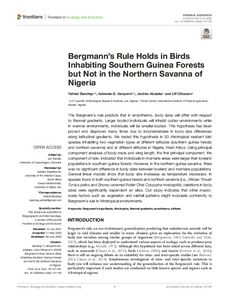| dc.contributor.author | Barshep, Y. |
| dc.contributor.author | Awoyemi, A.G. |
| dc.contributor.author | Abalaka, J. |
| dc.contributor.author | Ottosson, U. |
| dc.date.accessioned | 2022-07-04T11:34:15Z |
| dc.date.available | 2022-07-04T11:34:15Z |
| dc.date.issued | 2022 |
| dc.identifier.citation | Barshep, Y., Awoyemi, A.G., Abalaka, J. & Ottosson, U. (2022). Bergmann's rule holds in birds inhabiting southern Guinea forests but not in the northern Savanna of Nigeria. Frontiers in Ecology and Evolution, 10: 741755, 1-7. |
| dc.identifier.issn | 2296-701X |
| dc.identifier.uri | https://hdl.handle.net/20.500.12478/7535 |
| dc.description.abstract | The Bergmann’s rule predicts that in endotherms, body sizes will differ with respect to thermal gradients. Larger bodied individuals will inhabit colder environments while in warmer environments, individuals will be smaller-bodied. This hypothesis has been proved and disproved many times due to inconsistencies in body size differences along latitudinal gradients. We tested this hypothesis in 30 Afrotropical resident bird species inhabiting two vegetation types at different latitudes (southern guinea forests and northern savanna) and at different altitudes in Nigeria, West Africa. Using principal component analyses of body mass and wing length, the first principal component, the component of size, indicated that individuals in montane areas were larger than lowland populations in southern guinea forests. However, in the northern guinea savanna, there was no significant difference in body sizes between lowland and montane populations. General linear models show that body size increases as temperature decreases. In species found in both southern guinea forests and northern savanna (i.e., African Thrush Turdus pelios and Snowy-crowned Robin Chat Cossypha niveicapilla), variations in body sizes were significantly dependent on sites. Our study indicates that other macroscale factors such as vegetation and rainfall patterns might modulate conformity to Bergmann’s rule in Afrotropical environments. |
| dc.description.sponsorship | Leventis Foundation |
| dc.format.extent | 1-7 |
| dc.language.iso | en |
| dc.subject | Birds |
| dc.subject | Forests |
| dc.subject | Nigeria |
| dc.title | Bergmann's rule holds in birds inhabiting southern Guinea forests but not in the northern Savanna of Nigeria |
| dc.type | Journal Article |
| cg.contributor.affiliation | A.P. Leventis Ornithological Research Institute, Nigeria |
| cg.contributor.affiliation | International Institute of Tropical Agriculture |
| cg.coverage.region | Africa |
| cg.coverage.region | West Africa |
| cg.coverage.country | Nigeria |
| cg.coverage.hub | Headquarters and Western Africa Hub |
| cg.identifier.bibtexciteid | BARSHEP:2022 |
| cg.isijournal | ISI Journal |
| cg.authorship.types | CGIAR and developing country institute |
| cg.iitasubject | Biodiversity |
| cg.journal | Frontiers in Ecology and Evolution |
| cg.notes | Open Access Journal; Published online: 09 Jun 2022 |
| cg.accessibilitystatus | Open Access |
| cg.reviewstatus | Peer Review |
| cg.usagerightslicense | Creative Commons Attribution 4.0 (CC BY 0.0) |
| cg.targetaudience | Scientists |
| cg.identifier.doi | https://dx.doi.org/10.3389/fevo.2022.741755 |
| cg.futureupdate.required | No |
| cg.identifier.issue | 741755 |
| cg.identifier.volume | 10 |
| cg.contributor.acknowledgements | We would like to thank visiting researchers, colleagues and staff at A.P. Leventis Ornithological Research Institute, and at IITA, who were part of the trapping and ringing of birds at the four different localities. This contribution no. 210 from A.P. Leventis Ornithological Research Institute. We would also like to thank bird ring staff and visiting researchers at the A.P. Leventis Ornithological Research Institute for help in the field capturing and sampling the individual birds. |

